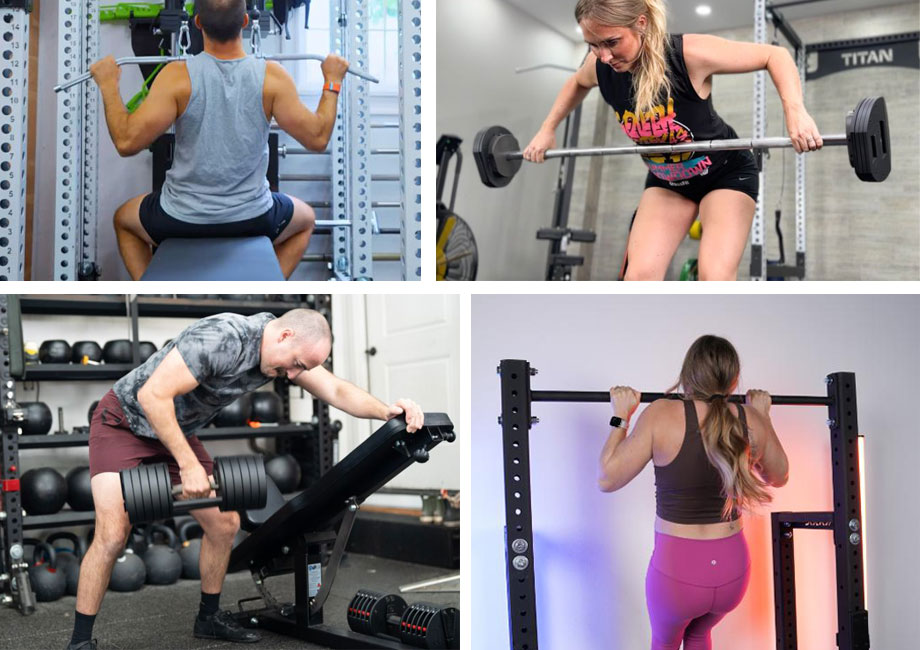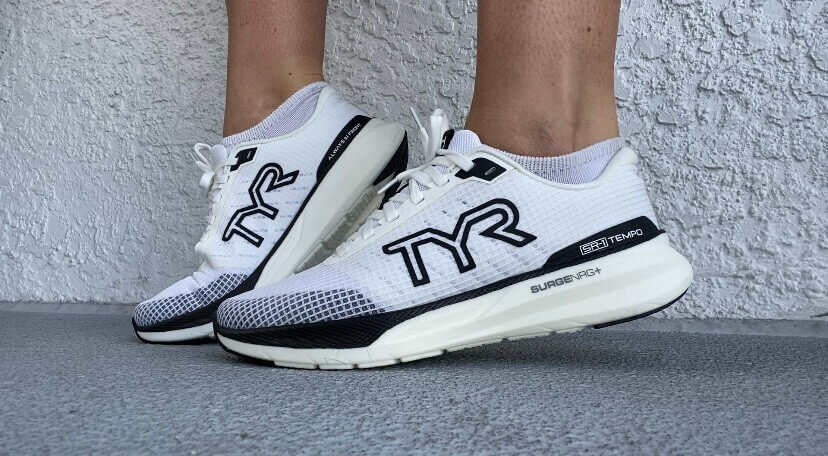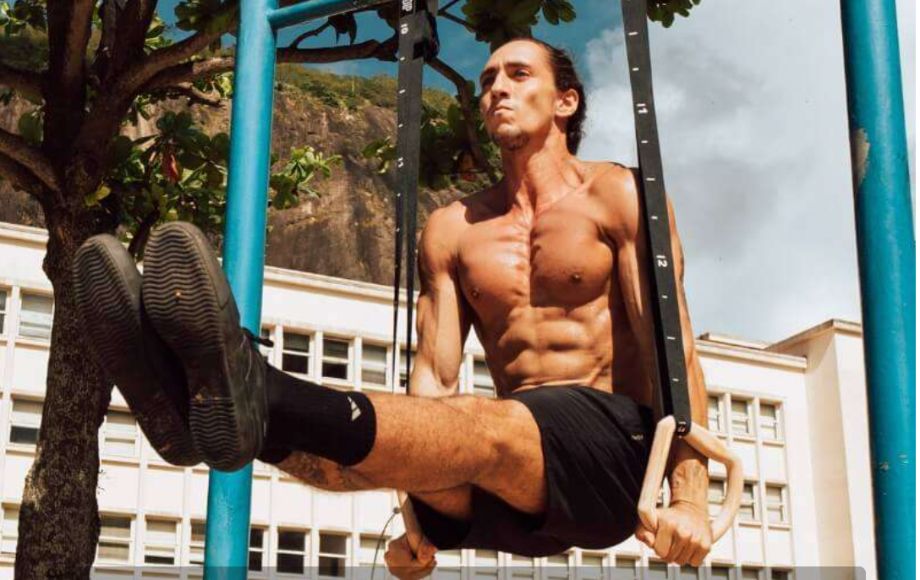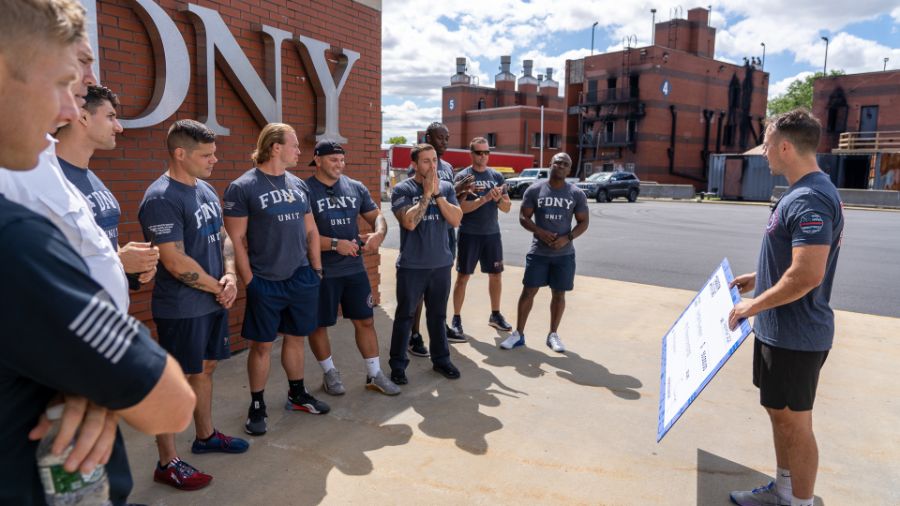As a competitive athlete and coach for most of my life, I’m a big fan of training for performance, not aesthetics. That said, I’d be lying if I said I never worked toward having a wide “cobra” back. A strong, large back is both impressive and effective in competition in Olympic weightlifting and other strength sports.
Plus, building powerful lats and other core muscles can help with your posture and reduce lower back pain1, making lat workouts an excellent fitness tool even if you’re not trying to perform snatches or deadlifts in a singlet routinely—like me.
Without workout variety, you can neglect areas of major muscles like the latissimus dorsi—particularly the lower lats. Sometimes exercises focus on the upper areas of the lats, while other times, you’re cutting out on the full range of motion for an exercise.
I’m here to show you 10 of the best lower lat exercises to add to your back workout routine. These exercises are sure to build and strengthen the lower lats, to ensure a bigger back all around. Below are a few common back exercises, like a bent row, along with some variations to add to your back workout.
RELATED: Best Lat Pulldown Machines
The 10 Best Lower Lat Exercises
- Wide-grip lat pulldown
- Bent-over barbell row
- Underhand bent-over row
- Single-Arm dumbbell row
- Seated cable row
- Seated resistance band row
- Straight-arm pulldown
- Dumbbell pullover
- Pull-up
- Inverted row
Some of the best exercises for the lats are pulldown exercises and row exercises. However, the range of motion and the type of grip can change the amount of focus on the lower lats. Here are the 10 exercises I recommend to target the lower lat muscles, along with tips to help target the back muscles more effectively.
Wide-Grip Lat Pulldown
Muscles worked: Latissimus dorsi muscles, trapezius, rhomboids, biceps, forearms, pectoralis major
Benefits: The wide-grip variation of the lat pulldown isolates the lats more so than the traditional close grip pulldown. With less elbow flexion, this lat pulldown variation focuses less on the biceps and forearms, rather on strengthening the upper-back muscle groups—particularly your outer and lower lats.
How to do it:
- Sit down facing a lat pulldown machine, securing your knees underneath a pad if one is available.
- Grip the lat bar with a wide overhand grip and lean back slightly.
- Pull the bar down toward your chest while keeping your back straight and core tight.
- Pause a moment once the bar is below your chin, then raise and guide the bar back to your starting position.
- Repeat for desired repetitions.
Expert tip: Bodybuilders might use a bit of momentum, or body English, on their high-rep hypertrophy sets. However, most people should focus on controlling the movement to get the most benefit out of their working sets. Minimize excessive momentum by choosing a working weight that you can handle and control on the way down and up.
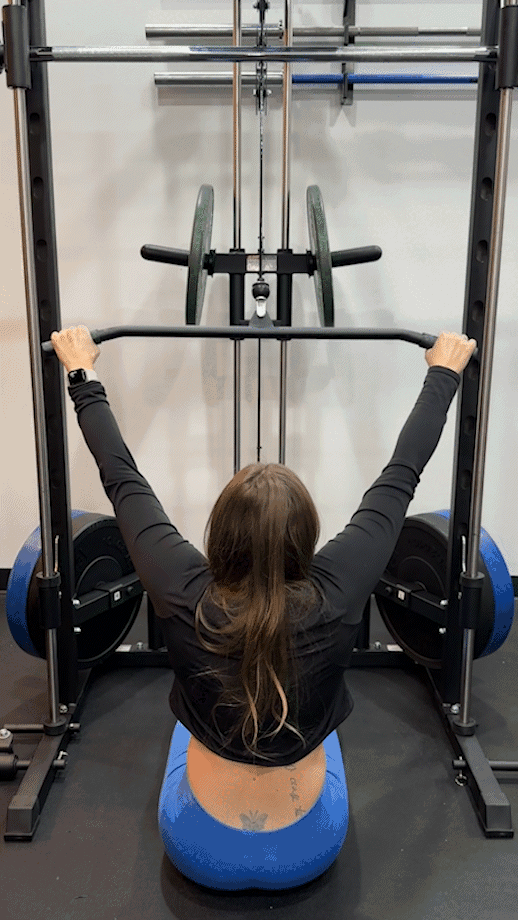
Bent-Over Barbell Row
Muscles worked: Latissimus dorsi, rhomboids, trapezius, posterior deltoids, hamstrings, glutes, biceps, forearms, core
Benefits: Bent-over barbell rows use many more muscle groups than isolation exercises like one-arm rows or cable rows. Because it’s a full-body exercise, you can load heavier weights than typical lat exercises, making this a great exercise for muscle growth in general. Building muscle with bent-over rows is vital if your aim is a back V-taper.
How to do it:
- Place an Olympic barbell on the ground, loaded to your desired weight.
- Step underneath the barbell with your feet placed shoulder-width apart, and the bar over your midfoot—similar to a deadlift stance.
- Squat down to grab the bar with an overhand grip (palms facing down to the ground), just outside of your shoulder-width stance.
- Deadlift the bar to standing, then brace your core and shift your hips back. You should have the bar close to your knees, and your upper body should be bent over the barbell.
- Row the barbell upward, just below your chest toward your abs. Keep your elbows close to your body as you move your arms.
- Pause at the top before lowering the barbell back to the starting position.
- Repeat for your desired reps.
Expert tip: Although this exercise focuses on lat contraction, the rest of the body should be in the proper position to ensure you’re getting the most out of this exercise. Keep the knees slightly bent and a neutral spine to reduce your chance of injury.
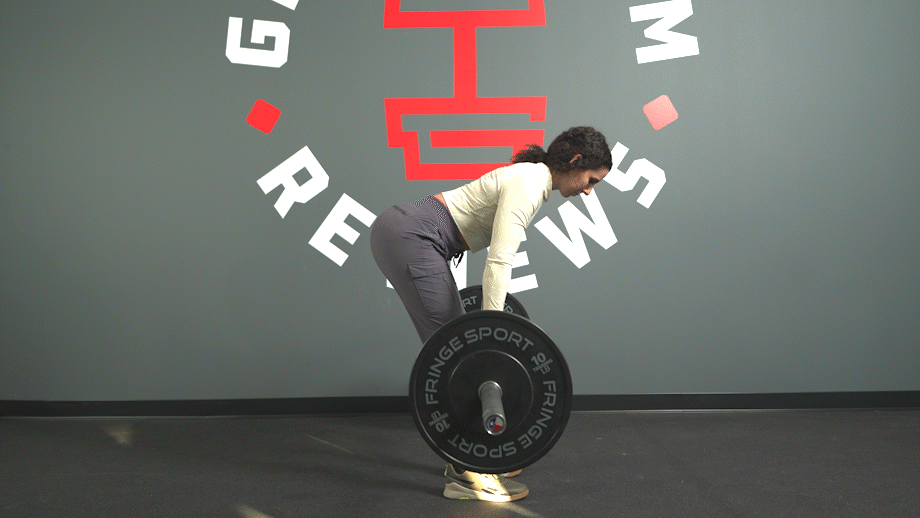
Underhand Bent-Over Row
Muscles worked: Latissimus dorsi, rhomboids, trapezius, posterior deltoids, erector spinae, hamstrings, glutes, biceps, forearms, core
Benefits: This variation of a bent-over row makes one small adjustment by flipping your grip around. This small change emphasizes your lower lats and back rather than your upper back. You’ll feel this variation a bit more in the lower lats and erector spinae. Bent rows also place you in a hip hinge position, which will have good carryover to your deadlift.
How to do it:
- Begin with your feet shoulder-width apart and a barbell placed in front of you.
- Grab the bar with an underhand grip—palms facing upwards—just slightly wider than shoulder width.
- Slightly bend your knees and shift your hips back so the barbell is resting at your knees and your upper body is over the bar.
- Squeeze your shoulder blades together and row the barbell up toward your stomach.
- Pause for a moment before lowering the weight back down.
- Repeat for reps.
Expert tip: Keep your elbows and arms tucked by your side throughout the movement to keep the exercise focused on your back and not your shoulders. This can be an odd position for shoulder exercises and could lead to injury if done wrong.
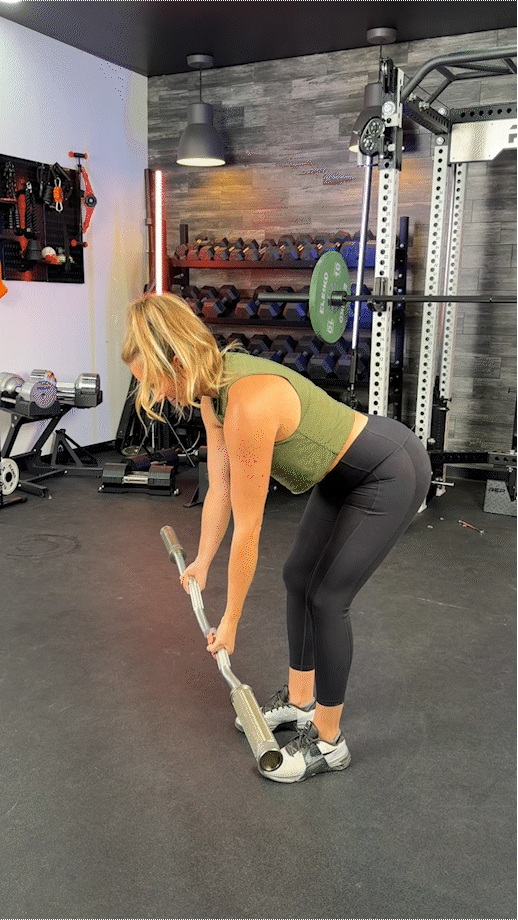
Single-Arm Dumbbell Row
Muscles worked: Latissimus dorsi, rhomboids, trapezius, posterior deltoids, biceps, forearms, core
Benefits: In addition to training the upper body and lats, the one-arm dumbbell row is a unilateral exercise, which can help correct muscle imbalances. Also, the neutral grip with a dumbbell may help relieve strain on the wrists compared to barbell movements.
How to do it:
- Place your left knee and left hand on a flat weight bench, with your right foot on the floor, with your toes pointed forward and a slight bend in your knee.
- Pick a dumbbell up from the floor with your right hand, and straighten your left arm, supporting your bodyweight.
- Row the dumbbell up and back, toward your hip, and pause at the top.
- Lower the dumbbell back to a hanging position with control, and allow your arm to elongate and stretch at the bottom.
- Repeat for your desired reps, then switch to the opposite side.
Modifications
- Dial it back: Using a resistance band instead of a dumbbell can help reduce the intensity of the exercise.
- Make it harder: Play around with pauses or eccentric (slow lowering) movements to increase the challenge. You can also incorporate your core more by doing a bent-over row variation of single-arm rows.
RELATED: Best Resistance Bands
Expert tip: A common mistake on the row is pulling up, not up and back. Pull and row the dumbbell back toward your hips, almost like you’re trying to fit the dumbbell in your pocket. This will help focus on lat activation and prevent excessive use of the shoulders and delts.
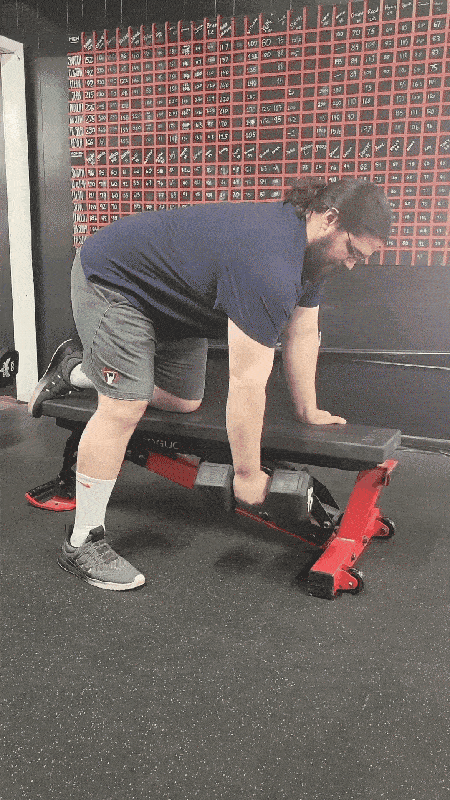
Seated Cable Row
Muscles worked: Latissimus dorsi, rhomboids, trapezius, erector spinae, biceps, triceps, core
Benefits: Working out on a cable machine can provide the stability that free weights don’t always have. Additionally, moving in a singular plane of motion allows for greater isolation of muscles. So, if you’re trying to focus on your back muscles, throwing some cable movements like a low-pulley seated cable row will allow you to isolate and attack specific back muscles.
How to do it:
- Attach a V-grip row attachment onto a low-pulley cable machine, and sit in front of it. The cable should be at chest height while seated.
- Plant your feet on the foot plates with a slight bend in your knees. If there are no foot plates, make sure you’re seated where your feet are planted firmly on the ground, anchoring your lower body.
- Grab the V-grip attachment with your arms fully extended, and then lower your shoulders down and back, sitting upright.
- Pull the attachment toward your lower abs, squeezing your shoulder blades back.
- Pause for a moment before returning your arms back to the starting position.
- Repeat for desired reps.
Expert tip: You’ll get the most out of a seated row by maintaining an upright torso and bracing properly. Leaning forward during a row removes tension from your back muscles, possibly straining your lower back.
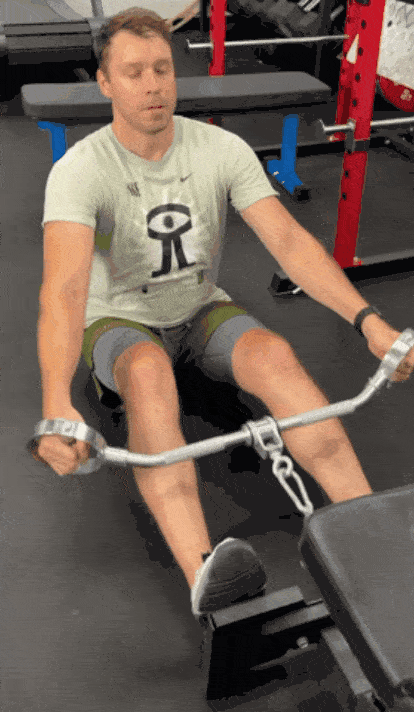
Seated Resistance Band Row
Muscles worked: Latissimus dorsi, rhomboids, trapezius, erector spinae, biceps, triceps, core
Benefits: Maybe you don’t have a seated row machine in your home gym. If not, you can get a similar movement with a band. A resistance band will keep your lats and back under constant tension throughout the entire movement and keep you in the proper positions you may be unable to maintain while doing barbell or dumbbell movements.
How to do it:
- Sit on the floor with your legs extended in front of you.
- Wrap a resistance band around your feet, keeping an end or handle in each hand. The band should be on your midfoot to prevent it from snapping back mid-rep.
- Keeping a tight core and straight back, extend your arms, then row back, leading with your elbows until they’re past your torso.
- Pause a moment, and then bring your arms back to the starting position.
- Repeat for your desired reps.
Expert tip: Remember to keep your elbows tucked at your sides while rowing back; this will help engage your lower lats more.
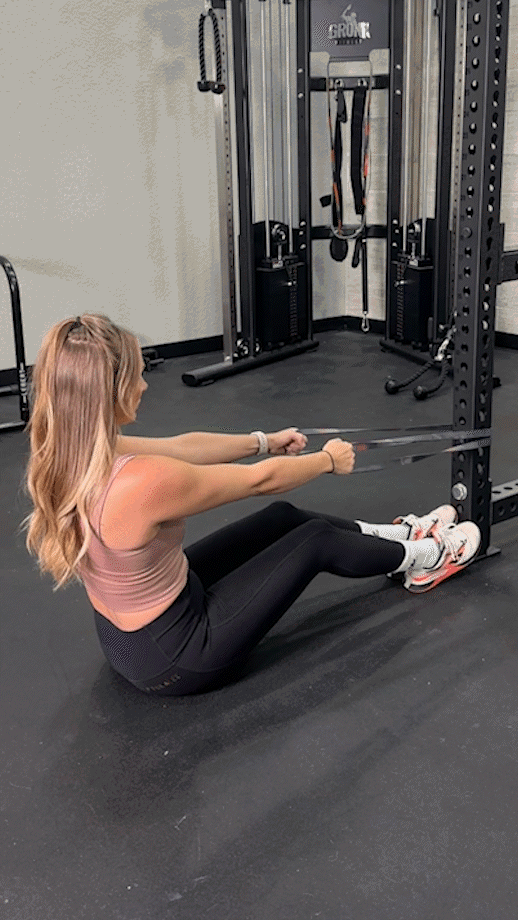
Straight-Arm Pulldown
Muscles worked: Latissimus dorsi, teres major, pectoralis major, deltoids
Benefits: The straight-arm pulldown—aka the lat sweep—is probably the closest you’ll get to fully isolating your lats, as other muscle groups are minimized by the nature of the movement. If you don’t have a cable machine to perform this movement, you can use a resistance band to mimic the same movement.
How to do it:
- Stand in front of a lat pulldown machine or a similar cable machine and attach a straight-bar.
- Use an overhand grip to grab the straight bar with your arms extended.
- Keeping your arms straight, push the bar downward by engaging your lats.
- Pause at the bottom, before controlling the straight bar back to the starting position.
- Repeat for the desired number of repetitions.
Modifications
- Dial it back: To reduce the intensity, you can use a resistance band instead of a cable machine.
- Make it harder: Add more weight to increase your resistance. You can also work one arm at a time for unilateral training.
Expert tip: Lean a little forward on the eccentric part of the movement—bringing the arms back up. Doing this will stretch the lats and ensure you get the full range of motion, shown to help increase muscle growth2 more than a partial range of motion focused on the concentric (or shortening) phase.
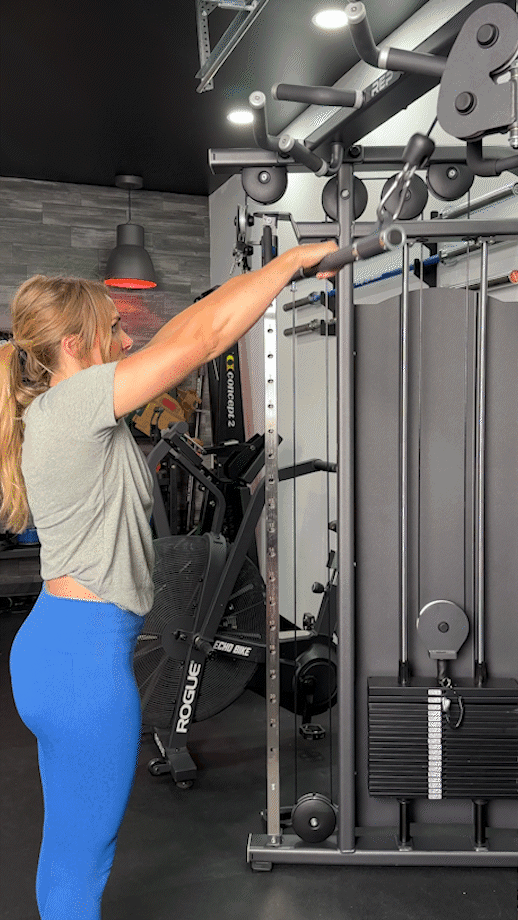
Dumbbell Pullover
Muscles worked: Latissimus dorsi, pectoralis major, triceps, deltoids, serratus anterior
Benefits: An April 2012 study3 found that eccentric, or lengthening, contractions of muscles can produce greater muscle adaptations than concentric (shortening contractions). Dumbbell pullovers put the lats in a nice stretch on every repetition, particularly in the lats and triceps. This stretch won’t just help with building strength, but it’ll have enormous carryover in shoulder mobility—vital for overhead movements like overhead presses or squats.
How to do it:
- Lie on a flat bench, making sure your hips, upper back and shoulder blades are supported.
- Grasp one dumbbell with both hands and position it over your head, with your arms slightly bent.
- Keep your body straight on the bench as you lower the dumbbell behind your head, maintaining the slight bend in your elbows and stretching your lats.
- Return the dumbbell back to the starting position over your head.
- Repeat for repetitions.
Expert tip: Any free weight works for a pullover. I commonly do pullovers with a heavy weight plate, but you could do it with a kettlebell, sandbag, or even a slam ball.
For a full-body exercise that engages the core more, place your shoulders on the bench so your body is perpendicular to it. While you do the pullovers, you can engage your posterior chain by doing a glute raise and hold, which will fire up your core muscles.
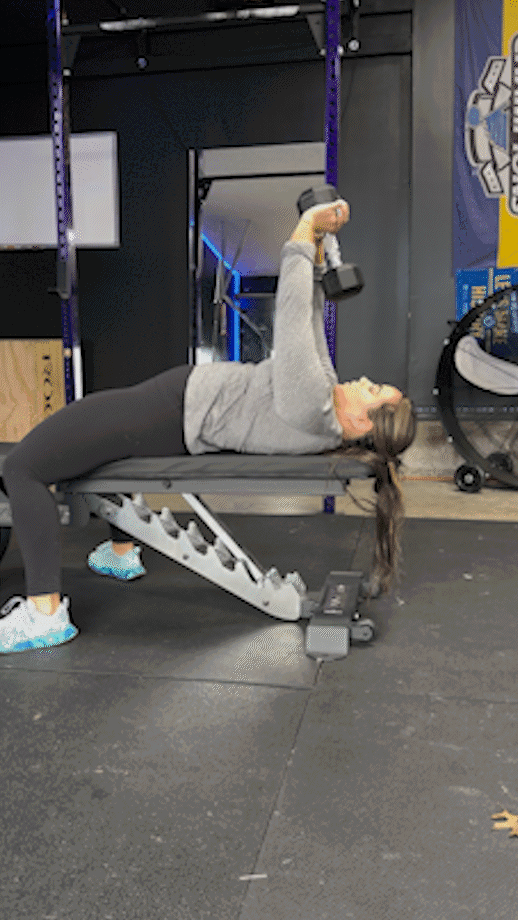
Pull-Up
Muscles worked: Latissimus dorsi, trapezius, rhomboids, erector spinae, deltoids, biceps, forearms
Benefits: The stretch of the dead hang of the pull-up to the contraction of the muscles—once your chin is over the bar—makes the pull-up one of the most effective bodyweight workouts for the upper arms and back. The movement will work the entire lat, too—upper, middle, and lower lats.
How to do it:
- Grab onto a pull-up bar with a shoulder-width overhand grip, making sure your arms are straight.
- Take your feet off the floor and hang from the bar. (Make sure to keep your upper back engaged, even while in a dead hang.)
- Pull yourself toward the bar by squeezing your lats, back, and arms. Aim for your chest to touch the bar, although it may not physically touch the bar. Aim for your chin to reach over the bar, however.
- Lower yourself down with control, keeping your upper back tight until your arms are straight.
- Repeat for the desired number of reps.
Modifications
- Dial it back: If unable to do a full pull-up, you can scale using a resistance band or an assisted pull-up machine (if you’re at a commercial gym). Additionally, you can adjust your grip if you do a chin-up or a neutral grip pull-up, although these variations will put more emphasis on your biceps and less on your lats.
- Make it harder: Loading pull-ups with a dumbbell or a weight belt can help make pull-ups more difficult. You can also experiment with tempos and pauses to increase the challenge.
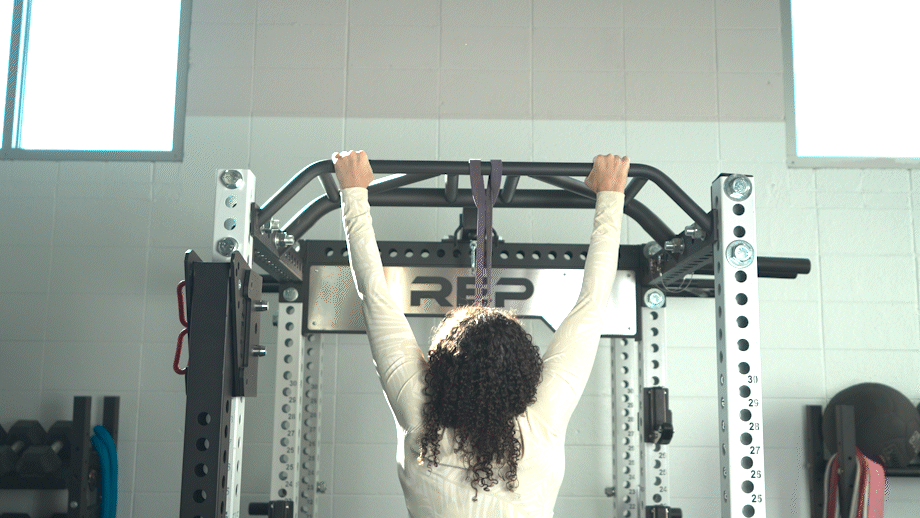
Inverted Row
Muscles worked: Latissimus dorsi, trapezius, rhomboids, posterior deltoids, biceps, forearms
Benefits: Inverted rows can be a great scaling option for pull-ups, as this bodyweight movement is far easier, and can be further adjusted by the angle of your body. Furthermore, inverted rows force you to maintain a strong, braced core, getting a bit of core work into the exercise.
How to do it:
- Set a barbell at about waist height on a power rack or other squat rack.
- Hang underneath the bar facing up, gripping it with your hands shoulder-width apart. Make sure to use an overhand grip.
- Keep your body straight by bracing your core and maintaining a neutral spine.
- Pull your chest toward the bar by squeezing your shoulder blades back and keeping your elbows tucked in toward your body.
- Pause for a moment before controlling yourself back down to the starting position.
- Repeat for your desired reps, making sure to maintain good form throughout.
Modifications
- Dial it back: If the bar at waist height is proving too difficult, raise the barbell height to make reps easier.
- Make it harder: For more challenging inverted rows, lower the barbell height on the rack.
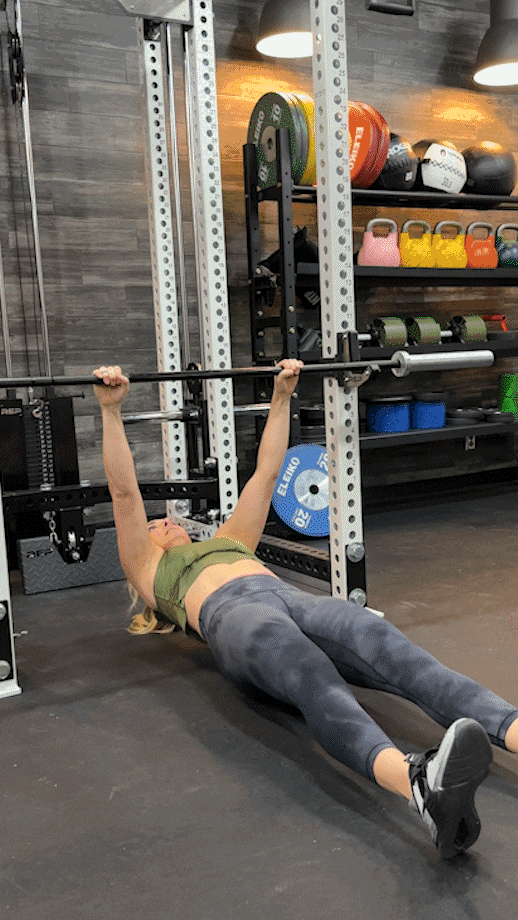
Sample Lower Lat Workouts
Now that we’ve gone over some classic lower lat exercises, I’ve created some basic workouts geared toward building all parts of the latissimus dorsi—but primarily the lower lats—to develop a solid V-taper in your back.
Lower Lat Workout for Beginners
Beginners may not want a workout specifically targeting their lower lats but, instead, desire a broader upper-back workout. This lower lat workout has some exercises that’ll train all of your back, whereas other parts will isolate more of your lats—particularly the lower lats.
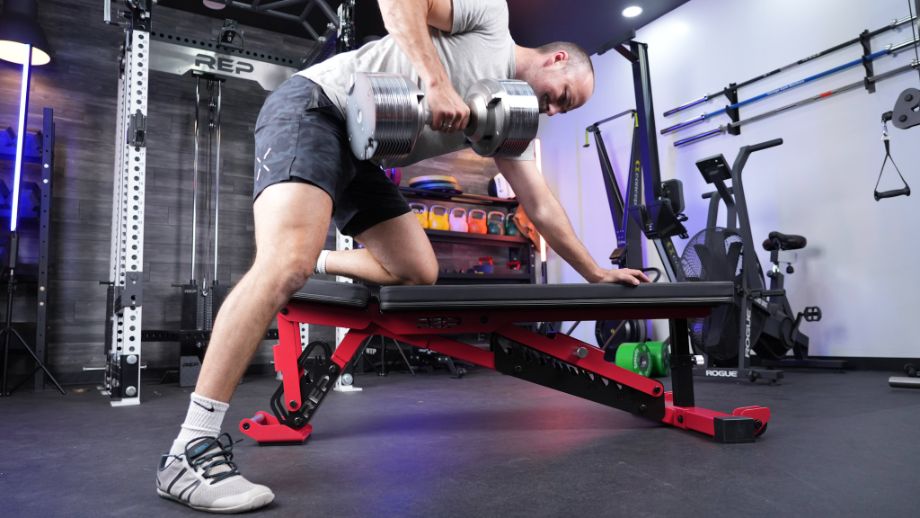
Also, a few warm-up and workout exercises add some unilateral movements to get a fair balance of strength and muscular symmetry.
RELATED: Best Warm-Up Exercises
Warm-up: Perform 1 to 2 sets
- Banded pull-apart: 8 reps
- Bird dog: 8 reps each side, alternating
- Plank hold with shoulder tap: 12 reps each side, alternating
- Banded straight-arm pulldown: 10 reps
- Inverted row: 8 reps
| Exercise | Sets | Reps |
| Wide-grip lat pulldown | 4 | 6-10 |
| Dumbbell pullover | 3 | 8-12 |
| Single-arm dumbbell row | 3 | 6-10, each side |
| Seated resistance band row | 3 | 8-12 |
Equipment needed: Resistance band, dumbbells or kettlebell, cable machine
RELATED: Best Dumbbells
Lower Lat Workout for Strength
Typically, strength workouts tend to aim for fewer reps and heavier weights. This sample lower lat workout geared for strength takes a few compound exercises that focus primarily on the lats, with some variations isolating the lower lats more so. The rep count stays low to emphasize building strength.
Warm-up: Perform 2 to 3 sets
- World’s greatest stretch: 5 reps, each side
- Scapula circles: 10 reps
- Incline Y and T: 8 reps each position
- One-arm dumbbell row: 8 reps each side
| Exercise | Sets | Reps |
| Pull-up | 4 | 5-8 |
| Underhand bent-over row | 4 | 6-10 |
| Single-arm cable pulldown | 3 | 6-10 reps, each side |
| Seated cable row | 3 | 6-10 |
Equipment needed: Barbell, cable machine, dumbbells or kettlebell, pull-up bar
Lower Lat Workout for Hypertrophy
Looking to build more muscle? This hypertrophy-based workout uses high repetition counts to emphasize muscle growth. With some bilateral and unilateral exercises, you’re all but guaranteed a well-built workout geared toward muscle adaptation.
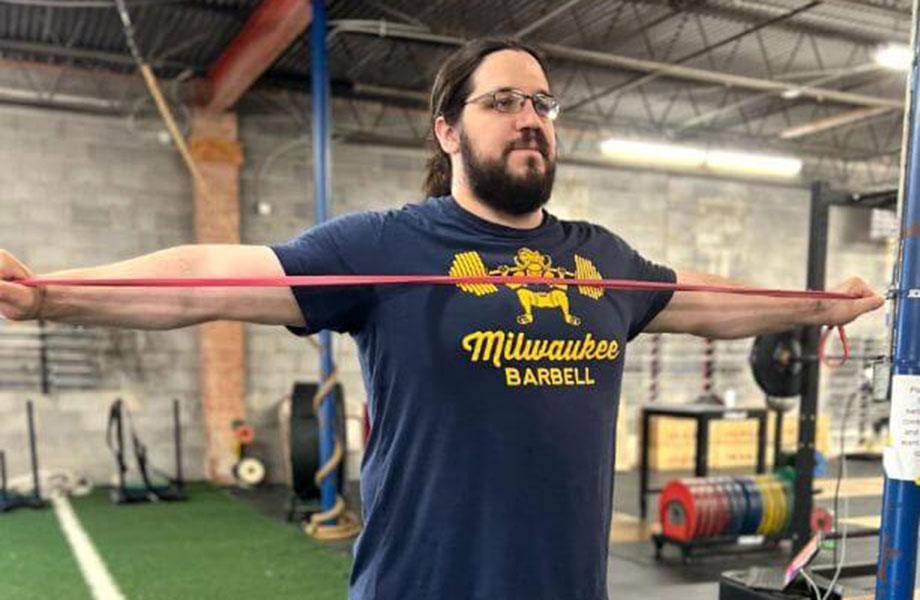
With this higher rep scheme, focus on moderate weights with minimal rest between sets—about 60 seconds.
Warm-up: Perform 2 to 3 sets
- Cat-cow stretch: 10 reps
- Scapular pull-ups: 8 reps
- Banded pull-apart: 10 reps
- Bird dogs: 10 reps, alternating
- Plank hold with shoulder taps: 10 reps each side, alternating
| Exercise | Sets | Reps |
| Straight-arm pulldown | 4 | 12-15 |
| Inverted row | 3 | 12-15 |
| Single-arm cable row | 3 | 12-15 each side |
| Dumbbell pullover | 3 | 16-20 |
Equipment needed: Pull-up bar, resistance band, cable machine, barbell (on a power rack), dumbbells or kettlebell
Benefits of Lower Lat Exercises
The lats are one of the largest muscles (and strongest) muscles in your upper body. Although they don’t get the attention as your chest or biceps, here are some compelling reasons why training your lats is vital to any strength training program.
Improves Strength and Performance
Although your lats sit in the upper back, they play a major role in many compound exercises—notably the squat, deadlift, and bench press. Your lats are engaged to keep upright posture during a back squat, or even a more dynamic movement like snatches or cleans.
The lats also help you maintain a strong core and neutral spine during the bench and deadlift. Lats help keep the spine strong in a multitude of positions, making strong lats a great boon for athletic performance and functional fitness.
Helps Reduce Lower Back Pain
Building a strong core—including the lats—can help improve your posture, which helps alleviate symptoms for people dealing with chronic back pain. A 2020 study4 found that core stability and hip exercises effectively increased physical function and activity by reducing pain intensity and instability among patients. Keeping a strong back and core can be helpful in improving your quality of life.

Getting That Aesthetic Look
Again, as an athlete, I should tell you that how your back looks is far less important than how it performs. However, for those looking to sculpt their bodies through the gym, the lats are helpful—necessary—in building the coveted V-shaped back of bodybuilders. Muscular lats will help broaden your upper back and shoulders and make your waist appear smaller. Those that attack the lats will inevitably develop a big back—but more importantly, a strong back.
Common Lower Lat Exercise Mistakes
Throwing these exercises into your workout routine may help you build muscle in the lower lats, but avoiding these common errors will help you get the most out of your training program and maximize your gains.
Cutting the Full Range of Motion
Many bodybuilding programs try to do partial movements to isolate muscle groups and keep the targeted muscles under tension for longer. While that type of training can have its place, a 2023 systematic review2 indicated that a full range of motion on movements tends to have better muscle growth and hypertrophy results.
RELATED: Bodybuilding Workouts
Make sure you’re doing these exercises with the full range of motion, focusing on the shortening of muscles and the lengthening of them—the eccentric portion of the exercise. This will help you build strength and muscle faster than partial reps.
Not Using Straps…Sometimes
Although some lifting coaches might tell you not to use straps, they have a place in hypertrophy training, as they can help isolate muscle groups further. The best lifting straps reduce the grip needed to hold a barbell or dumbbell, lessening the forearm strength and isolating your back muscles more.
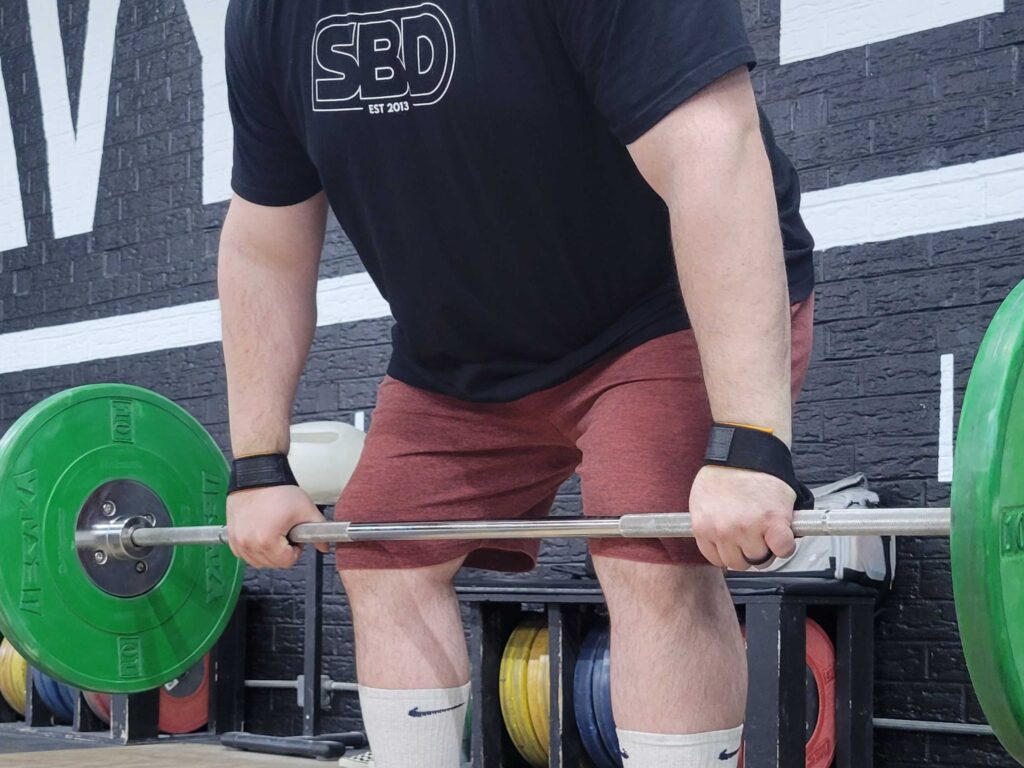
That said, I wouldn’t use them all the time, as you’ll miss out on developing serious grip strength, which can be an effective tool for isolation exercises.
Not Focusing on the Muscle Groups
While it’s easy to let your mind drift during a high-rep set of one-arm rows, I recommend that you focus on the task at hand, as studies show that it has the potential to get you more muscle gains.
A randomized controlled trial from 20185 took a group of college-aged men and had them train biceps curls; half of them focused on contracting the target muscle while training, and the other half just focused on the outcome of the lift. After eight weeks, those who concentrated on muscle contraction significantly increased their muscle growth compared to those who didn’t.
This study shows how a mind-muscle connection while training could help enhance muscle hypertrophy. While the amount of body awareness may not be the same for an elite athlete, you could get quite a boost just by focusing on the muscle’s activation during your exercise.
Lower Lat Exercises: FAQs
How do I target my upper and lower lats?
While many exercises will target both the upper and lower latissimus dorsi, some will use one area more than another. As a general rule of thumb, lat exercises with a wider grip will hit the upper lats more—like wide-grip pulldowns or pull-ups. Close-grip exercises like chin-ups, straight-arm pulldowns, and dumbbell pullovers will attack the lower lats more.
Why are my lower lats not growing?
If you’re having trouble developing your lower lats, you could try close-grip variations of exercises you’ve been doing, such as a straight-arm pulldown or dumbbell pullover, instead of a wide-grip lat pulldown. Additionally, try to get the full range of motion for each exercise to stretch your lats properly and engage the entire muscle.
What are the best exercises for strengthening and defining the lower lats?
If you’re looking for ways to strengthen your lower lats, try balancing between exercising your entire lat and using variations that isolate your lower lats. Here are the 10 best lower lat exercises I recommend:
-Wide-grip lat pulldown
-Barbell bent-over row
-Underhand bent-over row
-Single-arm dumbbell row
-Seated cable row
-Seated resistance band row
-Straight-arm pulldown
-Dumbbell pullover
-Pull-up
-Inverted row
References
- Shiri R, Coggon D, Falah-Hassani K. Exercise for the Prevention of Low Back Pain: Systematic Review and Meta-Analysis of Controlled Trials. Am J Epidemiol. 2018 May 1;187(5):1093-1101. doi: 10.1093/aje/kwx337. PMID: 29053873.
- Wolf, Milo & Androulakis-Korakakis, Patroklos & Fisher, James & Schoenfeld, Brad & Steele, James & Wolf, M & Steele,. (2023). Partial Vs Full Range of Motion Resistance Training: A Systematic Review and Meta-Analysis. 3. 10.47206/ijsc.v3i1.182.
- Moore DR, Young M, Phillips SM. Similar increases in muscle size and strength in young men after training with maximal shortening or lengthening contractions when matched for total work. Eur J Appl Physiol. 2012 Apr;112(4):1587-92. doi: 10.1007/s00421-011-2078-x. Epub 2011 Jul 14. PMID: 21755358.
- Kim B, Yim J. Core Stability and Hip Exercises Improve Physical Function and Activity in Patients with Non-Specific Low Back Pain: A Randomized Controlled Trial. Tohoku J Exp Med. 2020 Jul;251(3):193-206. doi: 10.1620/tjem.251.193. PMID: 32669487.
- Schoenfeld BJ, Vigotsky A, Contreras B, Golden S, Alto A, Larson R, Winkelman N, Paoli A. Differential effects of attentional focus strategies during long-term resistance training. Eur J Sport Sci. 2018 Jun;18(5):705-712. doi: 10.1080/17461391.2018.1447020. Epub 2018 Mar 13. PMID: 29533715.


